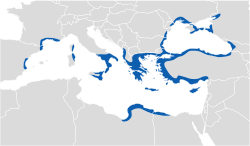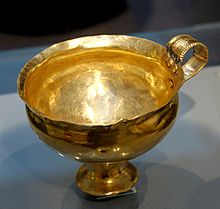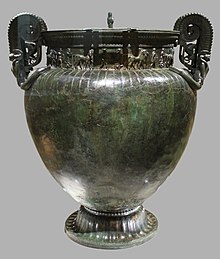Ancient Greece and wine
[1]The ancient Greeks pioneered new methods of viticulture and wine production that they shared with early winemaking communities in what are now France, Italy, Austria and Russia, as well as others, through trade and colonization.[3] In Minoan culture of the mid-second millennium BC, wine and the sacred bull were linked in the form of the horn-shaped drinking cups called rhyta; the name of Oinops (Greek: οἶνοψ, "wine-colored")[4] is twice attested in Linear B[5] tablets at Knossos[6] and repeated twice in Homer.[7] Along with olives and grain, grapes were an important agricultural crop vital to sustenance and community development; the ancient Greek calendar followed the course of the vintner's year.[citation needed] One of the earliest known wine presses was discovered in Palekastro in Crete, from which island the Mycenaeans are believed to have spread viticulture to others in the Aegean Sea and quite possibly to mainland Greece.[9] Early remnants of amphoras show that the Mycenaeans actively traded wine throughout the ancient world in places such as Cyprus, Egypt, Palestine, Sicily and southern Italy.Settlements in Massalia in southern France and along the shores of the Black Sea soon followed, with the expectation that not only would colonial wine production supply domestic needs, but also create trading opportunities to meet the demand of the nearby city-states.[citation needed] Athens itself provided a large and lucrative market for wine, with significant vineyard estates forming in the Attican region and on the island of Thasos to help satisfy demand.Millions of amphora pieces bearing the unique seals of various city-states and Aegean islands have been uncovered by archaeologists, demonstrating the scope of Greek influence.[2] A shipwreck discovered off the coast of southern France included nearly 10,000 amphoras containing nearly 300,000 litres (79,000 US gal) of Greek wine, presumably destined for trade up the Rhône and Saône rivers into Gaul.[10] The late Dionysiaca of Nonnus recounts the primitive invention of wine-pressing, credited to Dionysus, and Homer's description of the Shield of Achilles describes that part of its wrought decoration illustrating the grape harvest from a vineyard protectively surrounded by a trench and a fence; the vines stand in rows supported on stakes.[citation needed] Both Hesiod's writings and Homer's Odyssey include some of the earliest mentions of straw wine production: laying out freshly harvested grapes on mats to dry nearly to raisins before pressing.[2] As late as the Second Council of Constantinople in 691 AD, exactly three centuries after Theodosius closed the temples, a canon was issued expressly forbidding the cries of "Dionysus!"The wines most frequently cited as being of good quality were those of Chalkidike, Ismaros, Khios, Kos, Lesbos, Mende, Naxos, Peparethos (present-day Skopelos) and Thasos.The quantity of three bowls to represent moderation is a recurring theme throughout Greek writing (today, the standard 750 ml bottle contains roughly three to six glasses of wine, depending on serving size).





ancient GreeceMediterraneanbarbarismviticulturewine productionFranceAustriaRussiacolonizationEtruscansScythiansRomansNeolithicBronze Ageancient EgyptMinoan civilizationMycenaean GreeceMinoan palacesArchanesvilla rusticaMinoan culturesacred bullLinear BKnossosagriculturalancient Greek calendarwine pressesPalekastroAegean SeaDionysusGreek godAristaeusamphorasancient worldCyprusPalestineSicilyItalian PeninsulaMassaliaBlack SeaAthensAtticanThasosPortugalPhoeniciansGreek coinsCrimeaEtruriaamphoraarchaeologistsshipwreckRhôneSaôneVix GraveBurgundykraterterra cottaSatyrscult imageGreat GoddessPhrygiaArgonautsDionysiacaNonnusHomer'sShield of AchillesLaertesOdysseusTheophrastusvineyard soilsyieldssuckeringcuttingsvine trainingharvestingampelographersVitis viniferagrape varietyAglianicoGrechettoTrebbianomysticismroosterpigeageWickerearthenwarepithoifermentationHesiod'sOdysseystraw wineraisinswine made on Lesbosfree-run juicesweetnessseawaterperfumeRetsinamulled winevermouthSecond Council of ConstantinopleAriadneArchaeological Museum of Thessalonikidrachmawine bottlesChalkidikeIsmarosLesbosSkopelosPhoenician wineByblosArchestratusThraceIcariaSmyrnaAthenaeusAlkmanTaygetusMesseniaJancis RobinsonAristotleLemnióoreganoOxidationwine faultvintage
